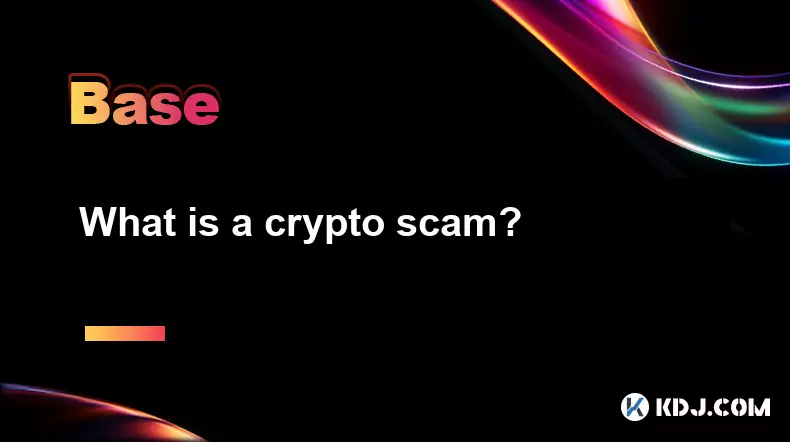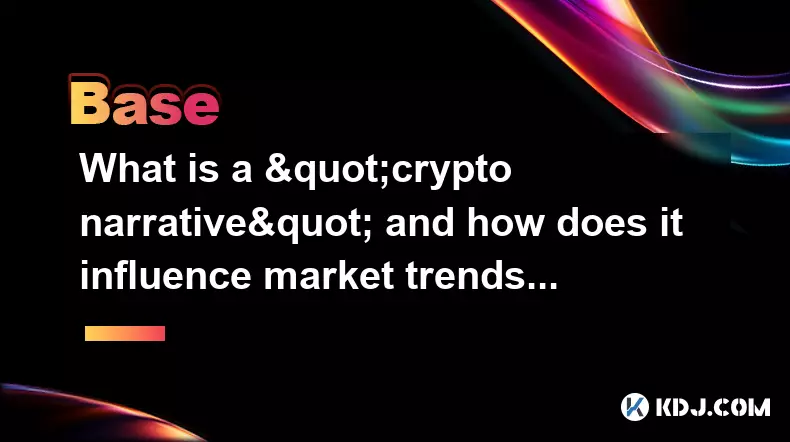-
 bitcoin
bitcoin $102877.190955 USD
1.88% -
 ethereum
ethereum $3430.435064 USD
4.52% -
 tether
tether $0.999264 USD
-0.05% -
 xrp
xrp $2.307310 USD
4.49% -
 bnb
bnb $987.740692 USD
3.82% -
 solana
solana $161.947760 USD
3.97% -
 usd-coin
usd-coin $0.999712 USD
-0.05% -
 tron
tron $0.292810 USD
2.93% -
 dogecoin
dogecoin $0.179738 USD
10.70% -
 cardano
cardano $0.580716 USD
8.75% -
 hyperliquid
hyperliquid $42.463448 USD
8.40% -
 chainlink
chainlink $15.763437 USD
7.05% -
 zcash
zcash $649.595636 USD
17.21% -
 bitcoin-cash
bitcoin-cash $511.610261 USD
7.19% -
 stellar
stellar $0.292537 USD
7.91%
What is a crypto scam?
Crypto scams exploit trust and technology, using fake ICOs, phishing, and impersonation to steal funds—always verify projects and never share private keys.
Sep 12, 2025 at 04:01 am

Understanding the Nature of Crypto Scams
1. A crypto scam refers to any deceptive practice in the cryptocurrency space designed to trick individuals into giving away their digital assets or personal information. These scams often exploit the decentralized and pseudonymous nature of blockchain technology to avoid detection. Victims are typically lured by promises of high returns, exclusive investment opportunities, or fake technological breakthroughs.
2. One common form is the fake initial coin offering (ICO), where fraudsters create a fictional project with a whitepaper, website, and social media presence. They collect funds from investors using smart contracts but never deliver the promised product. Once enough capital is gathered, the team disappears, leaving investors with worthless tokens.
3. Another prevalent method involves phishing attacks. Scammers send emails or messages that appear to come from legitimate crypto exchanges or wallet providers. These messages contain links to counterfeit websites where users unknowingly enter their private keys or login credentials, resulting in immediate loss of funds.
4. Social media impersonation is also widespread. Fraudsters pose as well-known figures in the crypto community, such as developers or influencers, promoting fraudulent giveaways. They instruct followers to send a small amount of cryptocurrency to receive a larger sum in return, which never materializes.
5. Ponzi and pyramid schemes remain active in the crypto ecosystem. These operations use funds from new investors to pay returns to earlier participants, creating the illusion of profitability. The scheme collapses when new investments dry up, causing most participants to lose their money.
Common Red Flags of Fraudulent Projects
1. Unrealistic promises of guaranteed returns should raise immediate suspicion. Legitimate crypto investments carry risk, and no project can assure consistent profits. Any platform claiming otherwise is likely attempting to mislead potential victims.
2. Lack of transparency around the development team is another warning sign. Reputable projects usually provide verifiable information about their founders and contributors. If team members are anonymous or have falsified LinkedIn profiles, caution is warranted.
3. Poorly written whitepapers with vague technical details or plagiarized content indicate a lack of genuine development effort. Authentic projects invest time in creating comprehensive documentation that clearly explains their technology and roadmap.
4. Aggressive marketing campaigns on social media, especially those using bots to inflate engagement, are frequently associated with scams. High-pressure tactics urging quick investment decisions are designed to prevent critical thinking.
5. Absence of code repositories or inactive GitHub pages suggests the project may not have real software development behind it. Open-source code allows the community to audit functionality and security, a standard practice among credible blockchain initiatives.
How Scammers Exploit Human Psychology
1. Fear of missing out (FOMO) is heavily leveraged by fraudsters. By creating artificial scarcity or time-limited offers, they push individuals to act impulsively without conducting proper research. This emotional manipulation overrides rational decision-making.
2. Authority bias plays a significant role. When a scam appears to be endorsed by a trusted figure or institution, people are more likely to believe it. Deepfake videos and hacked accounts have been used to simulate celebrity endorsements for fake crypto ventures.
3. Social proof is manipulated through fake testimonials, doctored screenshots of profits, and bot-driven hype on forums and chat groups. Seeing others appear to benefit encourages new participants to join, unaware they are entering a staged environment.
4. Overconfidence in one’s ability to detect fraud can lead even experienced investors to lower their guard. Scammers craft sophisticated narratives that appeal to knowledgeable users, incorporating real industry terminology to appear legitimate.
5. Victims often hesitate to report scams due to embarrassment or belief that recovery is impossible. This silence allows perpetrators to continue operating and targeting new individuals.
Protecting Yourself in the Crypto Ecosystem
1. Always verify the authenticity of websites and communication channels. Check URLs for slight misspellings and confirm official links through trusted sources. Bookmark official exchange and wallet sites to avoid accidental navigation to fakes.
2. Use hardware wallets to store large amounts of cryptocurrency. These devices keep private keys offline, significantly reducing the risk of remote theft. Avoid keeping funds on exchanges longer than necessary.
p>3. Enable two-factor authentication (2FA) using an authenticator app, not SMS, which is vulnerable to SIM-swapping attacks. This adds a critical layer of security to account access.
4. Conduct independent research before investing. Review project history, team background, community sentiment, and third-party audits. Cross-reference information across multiple platforms to identify inconsistencies.
5. Never share private keys or recovery phrases with anyone. No legitimate service will ever ask for this information. Treat it as the most sensitive data in your possession.
Frequently Asked Questions
What should I do if I sent crypto to a scammer?Immediately stop any further transactions. Report the incident to the platform involved, if applicable. While blockchain transactions are irreversible, providing details to blockchain analysis firms or law enforcement may help track the flow of funds.
Are all anonymous crypto projects scams?No, some privacy-focused cryptocurrencies intentionally maintain team anonymity for security reasons. However, anonymity increases risk, so extra diligence is required when evaluating such projects.
How can I verify if a crypto giveaway is real?Official giveaways are announced through verified social media accounts and official websites. Legitimate projects never ask participants to send money to receive tokens. If you must pay to receive more, it is a scam.
Can fake crypto apps appear on official app stores?Yes, scammers have successfully uploaded counterfeit wallets and exchange apps to official stores. Always check developer names, reviews, and download counts. Research the app’s official URL before installing.
Disclaimer:info@kdj.com
The information provided is not trading advice. kdj.com does not assume any responsibility for any investments made based on the information provided in this article. Cryptocurrencies are highly volatile and it is highly recommended that you invest with caution after thorough research!
If you believe that the content used on this website infringes your copyright, please contact us immediately (info@kdj.com) and we will delete it promptly.
- Ripple (XRP) in 2026: Hold or Fold? A Look at XRP's Future and Emerging DeFi Alternatives
- 2025-11-08 18:35:01
- Zcash ZEC Coin Price Explosion: From Privacy Niche to Center Stage
- 2025-11-08 18:55:01
- Berachain Price Prediction: Navigating the Honeycomb Hype in Crypto
- 2025-11-08 18:55:01
- Arthur Hayes, Gold, and Bitcoin: A Modern Monetary Trinity?
- 2025-11-08 19:15:01
- Shiba Inu's Next Move: Navigating a Shifting Market
- 2025-11-08 19:20:01
- Pakistan's Crypto Crossroads: Balancing Opportunity with Asset-Backed Realities
- 2025-11-08 19:20:01
Related knowledge

How does a crypto insurance protocol work?
Nov 08,2025 at 12:39am
Understanding Crypto Insurance Protocols1. A crypto insurance protocol operates by offering financial protection against losses incurred from digital ...

What is an "exploit" versus a "hack" in the context of smart contracts?
Nov 09,2025 at 12:40am
Understanding Exploits in Smart Contracts1. An exploit refers to the utilization of a known vulnerability within a smart contract’s code to gain unint...

What is a decentralized storage network and how does it compare to cloud services?
Nov 07,2025 at 11:59pm
Understanding Decentralized Storage Networks1. A decentralized storage network distributes data across a peer-to-peer infrastructure rather than relyi...

What is a factory contract and how is it used to deploy other contracts?
Nov 08,2025 at 04:20am
Understanding Factory Contracts in Blockchain Development1. A factory contract is a smart contract designed to create and deploy other smart contracts...

What is "alpha" in crypto and how do people find it?
Nov 08,2025 at 06:19pm
Understanding Alpha in the Cryptocurrency Space1. In the context of cryptocurrency, 'alpha' refers to valuable, non-public information or insights tha...

What is a "crypto narrative" and how does it influence market trends?
Nov 08,2025 at 07:00am
Understanding the Concept of a Crypto Narrative1. A crypto narrative refers to the collective belief or story that emerges within the cryptocurrency c...

How does a crypto insurance protocol work?
Nov 08,2025 at 12:39am
Understanding Crypto Insurance Protocols1. A crypto insurance protocol operates by offering financial protection against losses incurred from digital ...

What is an "exploit" versus a "hack" in the context of smart contracts?
Nov 09,2025 at 12:40am
Understanding Exploits in Smart Contracts1. An exploit refers to the utilization of a known vulnerability within a smart contract’s code to gain unint...

What is a decentralized storage network and how does it compare to cloud services?
Nov 07,2025 at 11:59pm
Understanding Decentralized Storage Networks1. A decentralized storage network distributes data across a peer-to-peer infrastructure rather than relyi...

What is a factory contract and how is it used to deploy other contracts?
Nov 08,2025 at 04:20am
Understanding Factory Contracts in Blockchain Development1. A factory contract is a smart contract designed to create and deploy other smart contracts...

What is "alpha" in crypto and how do people find it?
Nov 08,2025 at 06:19pm
Understanding Alpha in the Cryptocurrency Space1. In the context of cryptocurrency, 'alpha' refers to valuable, non-public information or insights tha...

What is a "crypto narrative" and how does it influence market trends?
Nov 08,2025 at 07:00am
Understanding the Concept of a Crypto Narrative1. A crypto narrative refers to the collective belief or story that emerges within the cryptocurrency c...
See all articles





















![The Graph Price Prediction [GRT Crypto Price News Today] The Graph Price Prediction [GRT Crypto Price News Today]](/uploads/2025/11/07/cryptocurrencies-news/videos/690d4df44fe69_image_500_375.webp)



















































